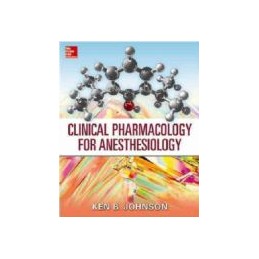- Reduced price

Order to parcel locker

easy pay


 Delivery policy
Delivery policy
Choose Paczkomat Inpost, Orlen Paczka, DHL, DPD or Poczta Polska. Click for more details
 Security policy
Security policy
Pay with a quick bank transfer, payment card or cash on delivery. Click for more details
 Return policy
Return policy
If you are a consumer, you can return the goods within 14 days. Click for more details
Publishers Note:: Products purchased from Third Party sellers are not guaranteed by the publisher for quality, authenticity, or access to any online entitlements included with the product.
Clinical Pharmacology for Anesthesiology incorporates the latest research and effectively details what anesthesia care providers must know about the drugs they use in everyday practice.
This comprehensive textbook uses a visual approach with an abundance of tables and illustrations to assist the practicing anesthesia care provider, resident, and student of anesthesia. The text begins with an overview of fundamental pharmacology concepts (pharmacokinetics, pharmacodynamics, and drug interactions) and then details all classes of drugs relevant to the anesthesiologist in a highly clinical manner.Features
Data sheet
Section I: A basic primer (i.e. easy to ready with lots of figures)
1. Pharmacokinetics
2. Pharmacodynamics
3. Biophase
4. Drug interactions
5. Covariates of interest (age, weight, comorbidities, etc).
Section II: For each drug, clincal features of: Pharmacokinetics (some interesting facts like % protien binding, volume of distribution, but more importantly, how age, weight, and comorbidities impact drug concentrations, how drugs behave when given as a bolus or as a continuous infusion); Pharmacodynamics; Simulations of onset and duration of effect for commonly used doses; Common toxicity issues and adverse features (focus only on those that anesthesia clinicians worry about); Unique characteristics (i.e. context sensitive half time); Common preparations (especially for drugs that have to be dissolved) and dosing regimens (bolus versus continuous infusion)
6. Analgesics
7. Sedatives
8. Inhalation Agents
9. Muscle Relaxants
10. Reversal Agents
11. Vasoactive Drugs (inotopres, chronotropes, cholinergic and anticholinergic drugs)
Section III: Drug interactions for commonly used anesthetic drug combinations: a look at analgesia for moderate and severe stimuli, sedation, loss of responsiveness, and muscle relaxation.
Section IV: Suggested dosing strategies for unique or challenging anesthetics. This section would be simulation based and use PK and combined drug PD interaction models.
12. Drug models
13. Preoperative sedation
14. Moderate sedation for MAC cases
15. Approaches to general anesthesia (conventional TIVA, and multimodal)
16. Post operative pain (both PACU and inpatient management)
Section V: Cases
17. Moderate sedation cases with more than minimal painful stimuli in the elderly (i.e.An approach to analgesia for a retrobulbar block).
18. A quick wake up after general anesthesia yet provide analgesia for moderate to severe surgical pain
19. An approach to opioid tolerant patients for surgeries associated with moderate to severe surgical pain
20. An approach to patients that have lost a considerable amount of blood
21. A clinicians guide to dosing PCAs especially in opioid tolerant patients
22. Dosing considerations for obese patients with sleep apnea
23. General anesthsia for patients with poor cardiac function
24. General anesthesia for patient with poor liver function
25.CABG or valve replacement,
26.Liver transplant
27. AAA repair
28. Aneurysm clipping
29. Aortic arch procedures that require cirulatory arrest.
